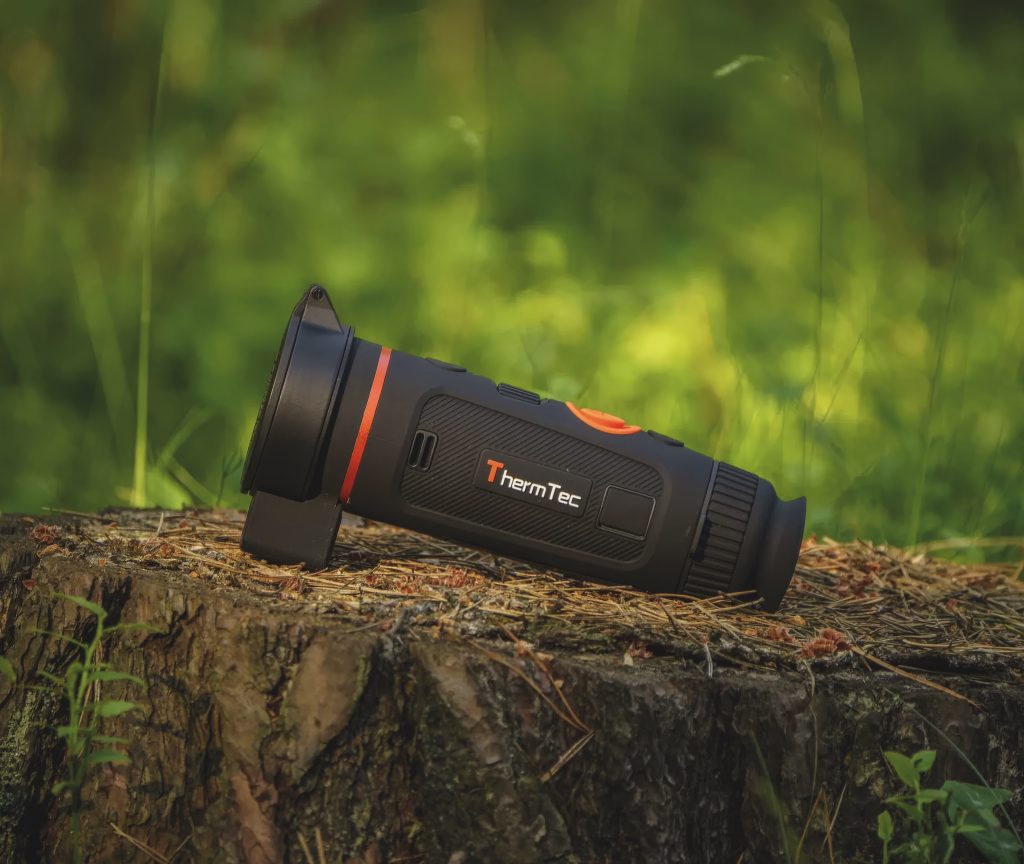Win CENS ProFlex DX5 earplugs worth £1,149 – enter here
How to clean a shotgun and keep it in top condition
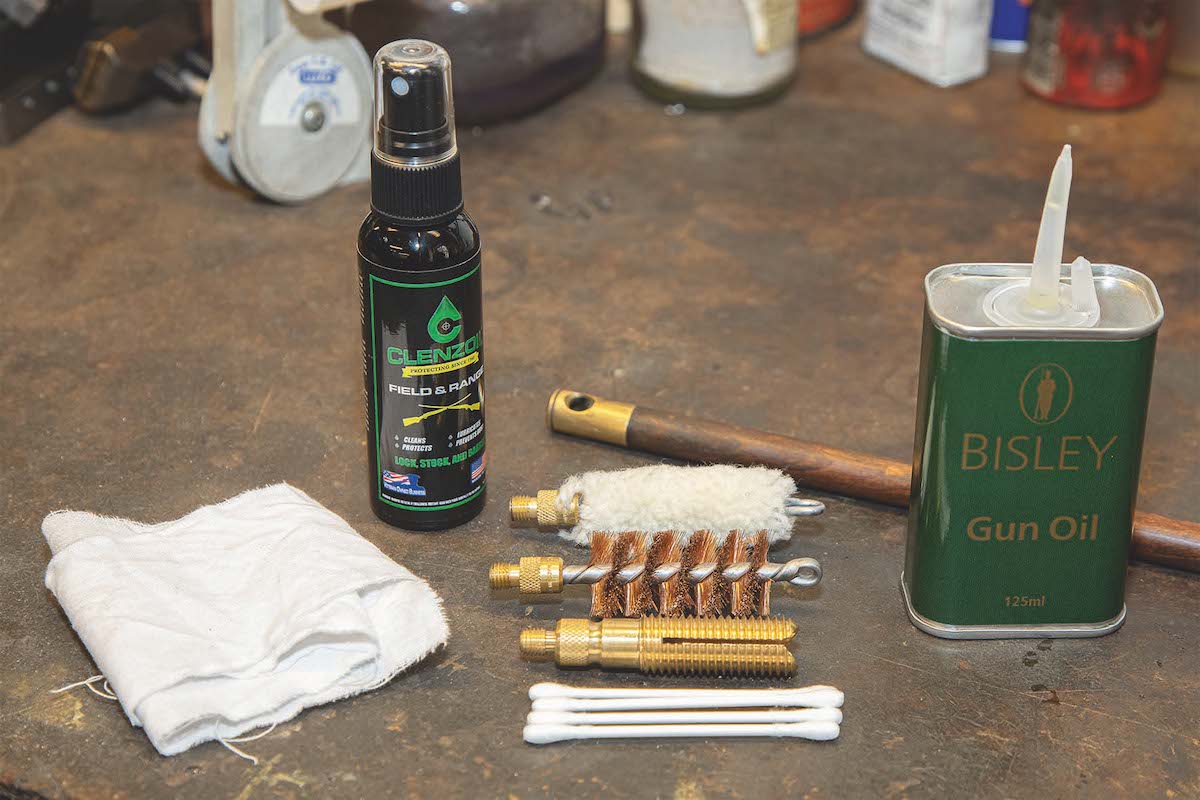 Usd SG March 20 gunsmith
Usd SG March 20 gunsmith
Keeping your gun in good working order will help it stay reliable and maintain its value over the years. But how to clean a shotgun? What lengths should you go to keep it in the best condition?
There are different views on the way guns are cleaned and how often. For example, my own gun is cleaned after every use, whereas at the shooting school where I coach the guns that are out every day are lucky if they get cleaned once a month. But these bare facts could be misleading. My own gun may get a quick once-over when it gets cleaned, but the school guns have a full strip on their monthly clean.
What you do with your gun is up to you, but the more you keep it in good order, the more years of service it will give you, as well as enhancing its resale value.
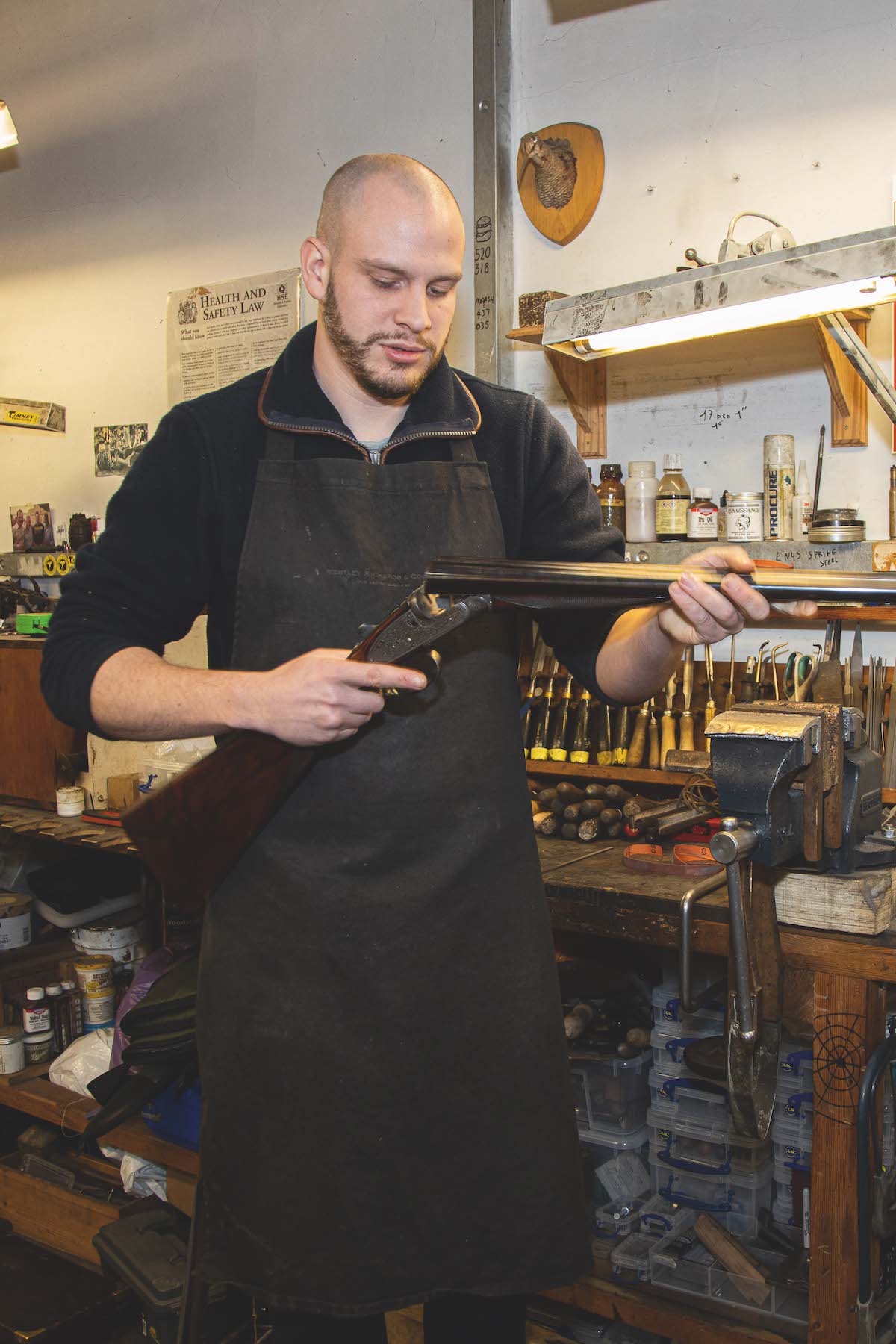
Keeping your gun in good order will pay dividends in the field
How to clean a shotgun
Get started
- The first thing you need to do is check that the gun is empty and safe. Then you can break the gun into its three main component parts.
- Once you have checked the gun is safe, still close it in such a way that it’s not pointed at anyone, and when it is closed and pointing up in a safe direction you can take the fore-end off. This is done by operating the fore-end catch located in the middle or end of the fore-end. For semi-automatic shotguns, the fore-end is secured by a nut on the end. Once the catch is released, the fore-end can be removed. (Read more on maintaining a semi-auto shotgun.)
- Now that the fore-end has been removed, the top-lever can be pushed as if you were opening the gun and the barrels will pivot off the action. With a semi-auto, the barrel will slide out from the action.
- You should now have the stock and action, fore-end and barrels to be cleaned before reassembling them.
- The fore-end is the quickest and easiest part to clean. Any screws visible should be checked for tightness.
- Metal parts should be wiped with a cloth with oil on it rather than spraying oil directly on to any parts of the gun as this can cause an excess of oil seeping into wooden parts and discolouring and weakening them. (Read our guide to the best gun oils.)
- Chequering can be cleaned out with a nylon toothbrush.
- Inside some fore-ends are ejector workings, which should be wiped over and cotton buds used to get into all the areas you can.
- On some side-by-sides, there may be a hole to put in a drop of oil to the fore-end release catch; one drop will do and then work the button at the end of the fore-end.
- Semi-auto fore-ends are usually free of workings but may contain vents for the gases that operate the action and these need a good clean.
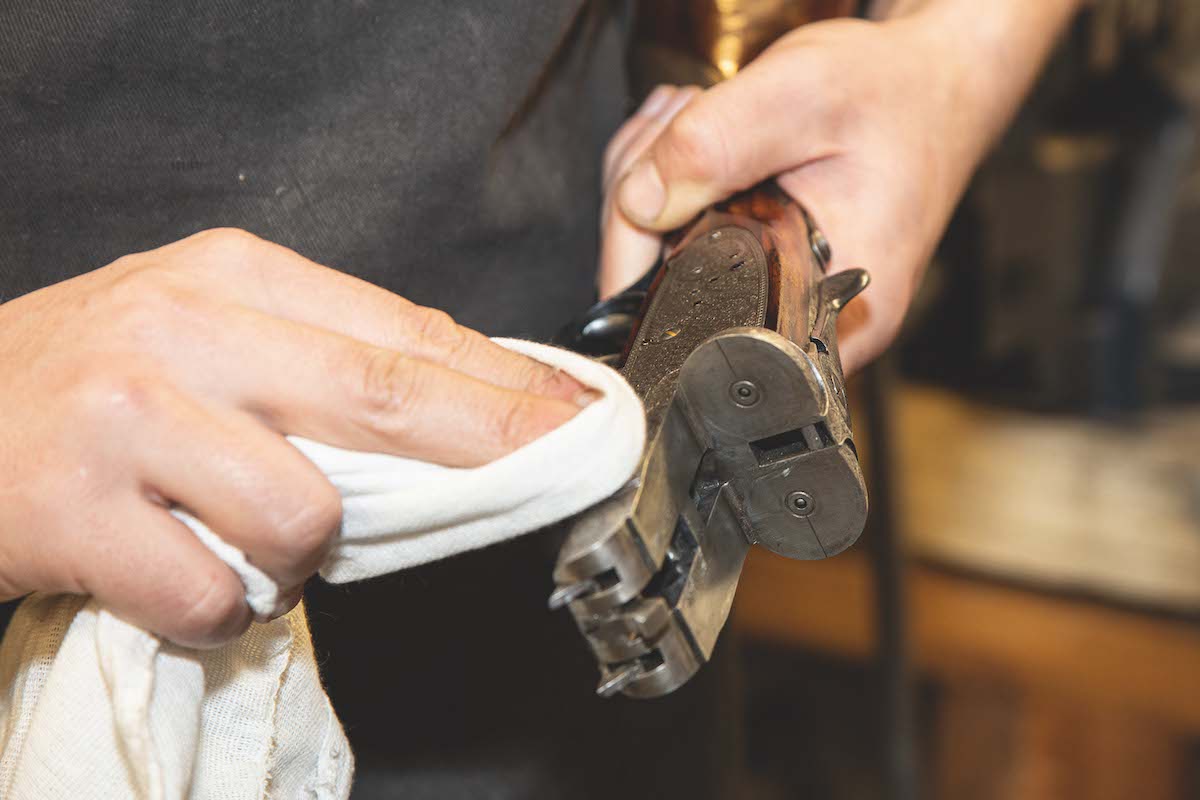
Good cotton cloths to wipe over gun parts are essential
Full strip
- The action and stock can stay together on a normal clean, but on a full strip the stock is taken off to reveal the workings. This should only be done if you are confident and you know what you are doing.
- On the action, the face will need a good clean as you will see the residue from the fired cartridges. Look for channels cut into the action for ejectors to work on and clean out with brush or cotton bud.
- Metal surfaces should be wiped with an oily cloth.
- For stubborn fouling you can use a toothbrush or special brushes that come with nylon, mild steel and phosphor bronze.
- On a semi-auto you will need to remove the bolt handle to remove the block and then be able to clean within the action and the block itself.
- How your stock is finished will depend on how you clean it. Any excessive mud should be cleaned off with a damp cloth.
- If you have a varnished or synthetic stock, this will be all it needs, but if you have an oil finish, then some stock oil may be required. (Read how can I restore the shine to my gun?)
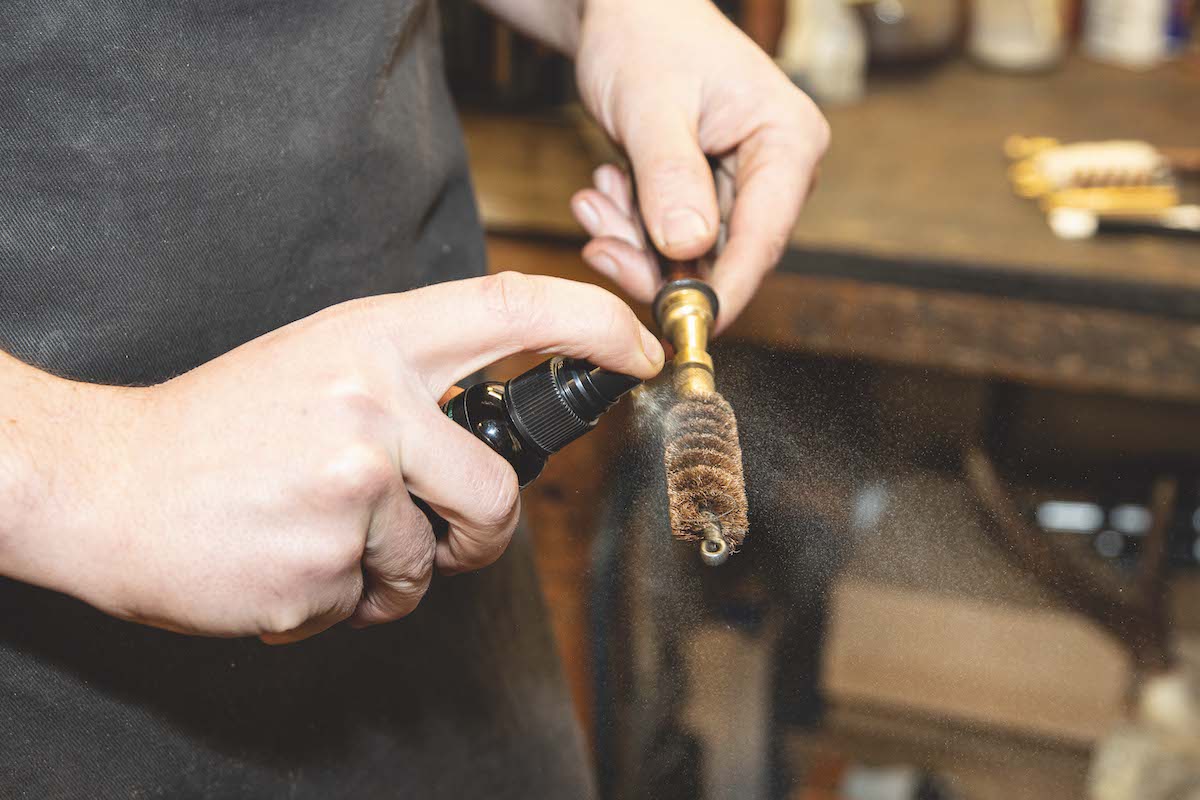
Spray bore cleaner on to a phosphor bronze brush
Barrels
- If you have a multichoke gun, the chokes can come out first to be cleaned. This does need doing regularly, as propellant gases can build up and bake them solid, making removing them very hard. Even if you never change your chokes, you still need to take them out regularly and clean them.
- Once they are clean, put them to one side and clean out the end of the barrel they go in, ensuring all the threads are clean.
- Oil or grease up your chokes with your preferred lubricant and return the chokes to the barrels.
- On a full strip, we would take the ejectors out and clean, relubricate and refit. This is easier on some guns than others, but if you are confident, doing it a couple of times a year should keep them in good order. If you can’t get the ejectors out, I would recommend a good clean around them.
- The barrel bores themselves need to be cleaned. This can easily be done with some bore cleaner and a phosphorous bronze brush, followed by a pass through with a paper towel to push out all the dirt. At work we use one square hand towel for 12-bore and 20-bore and half a sheet for smaller bores; at home I use two squares of toilet paper for 12-bore and 20-bore and one sheet for the smaller bores. Barrels with a high chrome content clean easily, but if you have barrels with a low chrome content, then you would be advised to clean them after every use to stop any corrosion within the barrel.
- Clean along the rib line and within the ventilated rib with a small brush to remove any hidden dirt. Some semi-auto shotguns will have gas valves or ports in the barrel that need to be kept clean with a toothpick or similar.
- Once all clean, wipe over with a fresh oily cloth rather than spraying directly on to the barrels.
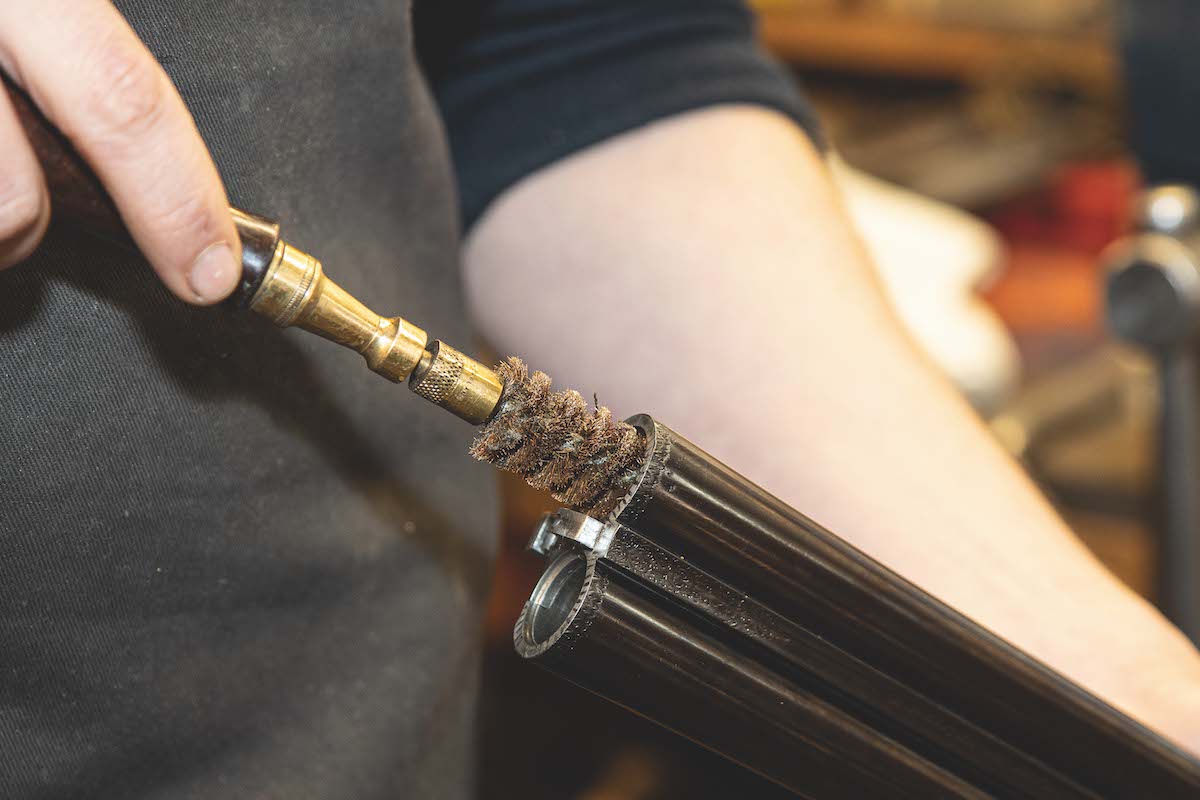
Thread the cleaning rod through the barrel bores
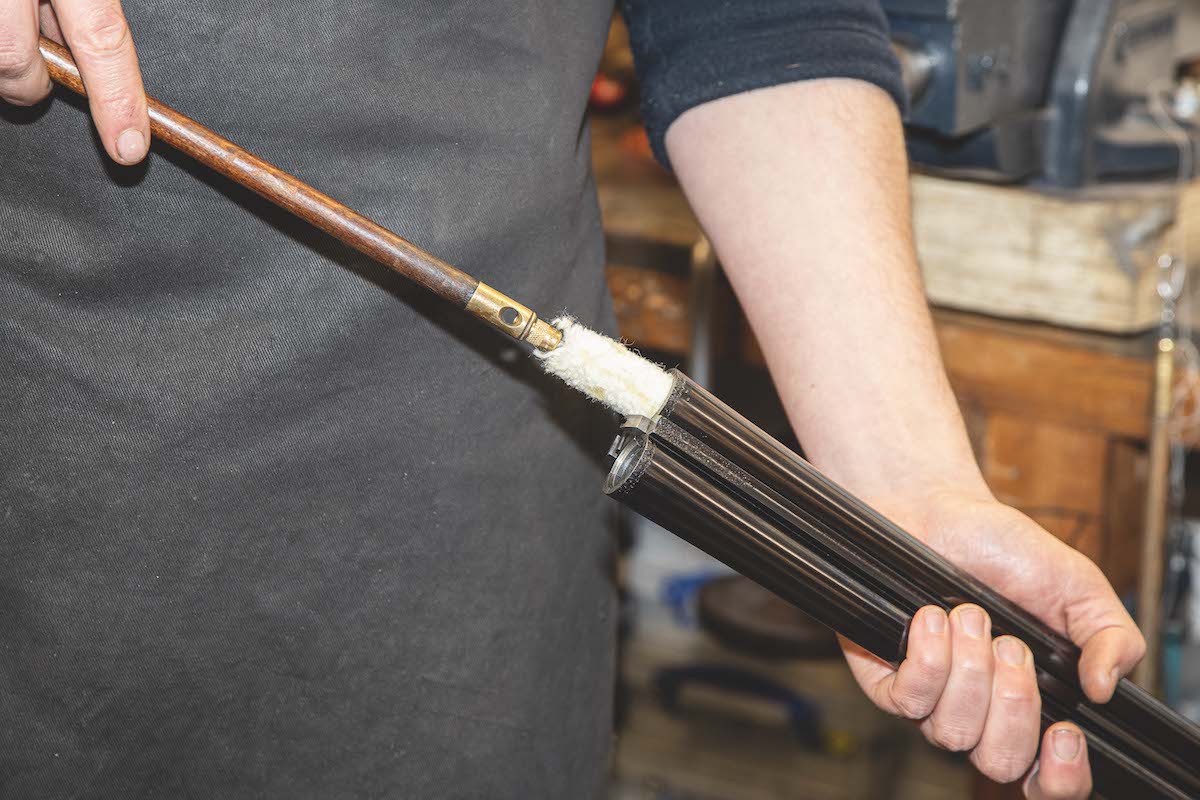
Follow with a soft brush or absorbent paper towels to push out all the dirt
Reassembly
Once all the parts are clean, reassemble the gun, making sure that it is empty and safe. You may think this is obvious as you have just cleaned it, but the use of snap caps allows a slim chance of loading live cartridges by mistake. When using snap caps, double check they are snap caps before releasing firing pins and storing. (Read more on snap caps here.)
Any metal-to-metal moving surfaces have some sort of lubricant to prevent wear. I like to use grease on all the surfaces, and though some say it helps bind the dirt into a grinding paste, I think that the grease keeps the dirt out and is cleaned off after each use. Dry metal on dry metal will work but potentially wear more quickly. Make time to look after your gun and your gun will look after you. As you are cleaning it, think about the great time you’ve had shooting it and look forward to your next session out with a nice clean gun.
What you need
The contents of a cleaning kit will vary from shooter to shooter, and the kit you have will grow as you find more stuff to make the job easier. As a starting point, you will need a cleaning rod. At first, you will have only one and change the heads, with phosphor bronze, wool mop and jag. As the years pass, however, you will no doubt gain more rods and you won’t need to change the heads; I even have a rod with no head just to push paper through.
You will also need gun oil, cleaning spray and grease if you use it. (Read our guide to the best gun oil.) Good cotton cloths to wipe over gun parts are essential. Again, start with one, then you will most likely accumulate cleaner ones, but keep the older oil-soaked cloths for wiping over metal parts. Paper towels or toilet roll are in order for barrel bores and removing old oil and grease, plus cotton buds to get into hard-to-reach areas. An old toothbrush, or similar, and a toothpick will do for starters.
This article was originally published in 2021 and has been updated.
Related Articles
Get the latest news delivered direct to your door
Subscribe to Shooting Times & Country
Discover the ultimate companion for field sports enthusiasts with Shooting Times & Country Magazine, the UK’s leading weekly publication that has been at the forefront of shooting culture since 1882. Subscribers gain access to expert tips, comprehensive gear reviews, seasonal advice and a vibrant community of like-minded shooters.
Save on shop price when you subscribe with weekly issues featuring in-depth articles on gundog training, exclusive member offers and access to the digital back issue library. A Shooting Times & Country subscription is more than a magazine, don’t just read about the countryside; immerse yourself in its most authoritative and engaging publication.







